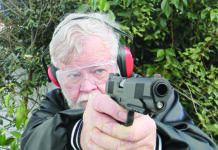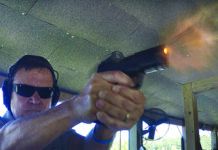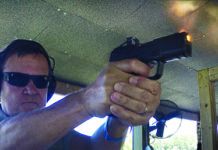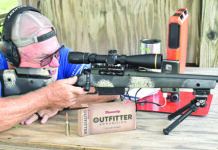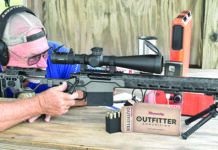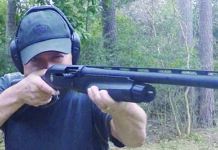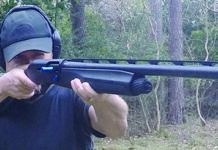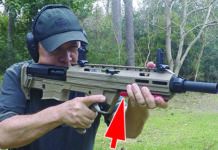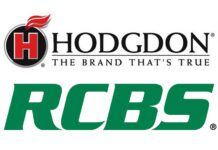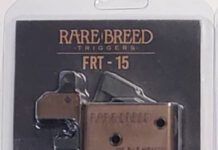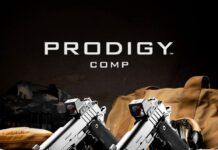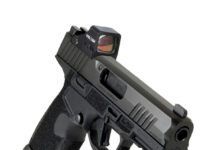This months Downrange takes aim at the efforts of a group to drive Californias manufacturers of cheap auto-loaders out of business. The group is assisted by data indicating that such handguns are disproportionately used in the commission of crimes.
Since statistics are so easily manipulated, well say neither yea nor nay to that purported fact, but we have published some pretty harsh words on budget-priced pistols in the past. For example, our report on the AMT .380 Back Up complained of the pistols lack of any visual means to determine whether or not its cocked, and we revealed that it jammed 20 times during our 300-round test. About AMTs .22 Automag, our bottom line recommendation was a blunt dont waste your money.
We found Brycos Model 48 jammed repeatedly with a safety and trigger so problematic our shooters developed blisters on their fingers. Of the same companys Model 59 13-shot 9mm, we advised readers to stay away from it until the manufacturer figured out a way to keep the gun from self-destructing. We gave Lorcins L-22 and L-380 an unacceptable and dont buy respectively and recommended Sundance Industries take its .25-caliber BOA back to the drawing board.
As this months editorial suggests, we believe the Second Amendment is here to protect everyone, not just those who can afford pricey firearms. But buying a low-priced firearm is a complete waste of money if the product in question fails to function when its needed most. Youre much better off with no gun at all.
With that in mind, Gun Tests set out to find an affordable self-defense weapon that offered some assurance that it would shoot straight and function reliably after several hundred rounds.
What we found wasnt very reassuring. Of the three cheap 9mm pistols we acquired for this test, only the Jennings Model Nine was reliable. The Hi-Point JS-9s functioning and accuracy were ammunition sensitive. The Lorcin L-9mm destroyed itself. All of these blowback-operated pistols utilized similar, uncomplicated striker-type firing mechanisms.
How We Tested
During this head-to-head test, each pistol was fed 200 rounds of commercial 9mm ammunition. Accuracy testing was done indoors at 15 yards using a pistol rest. Five 5-shot groups were fired with each of three kinds of ammunition: Winchester 115-grain Silvertip hollow points, Federal 124-grain Hydra-Shok hollow points and UMC 115-grain metal case. Accuracy and velocity results are in the performance table.
Here are the results of our examinations:
Jennings Model Nine
The origin of this $145 9mm pistol can be confusing. The Jennings Model Nine is manufactured by Bryco Arms in California and distributed by Jennings Firearms of Carson City, Nevada. It features a single action trigger, a 3 5/8-inch barrel and partially-adjustable sights. According to the sales literature, this model comes with two 10-round magazines.
Physical Description
For a modestly-priced pistol, the Model Nines appearance was more than acceptable. It had a highly polished blue/black finish. Except for the slides steel breech insert, it and the frame were made entirely of a zinc alloy. The fixed steel barrel was solidly pinned to the frame. There was a sharp edge on the disassembly lever that came into contact with the shooters hand. Fitting of moving parts was average.
This Jennings was equipped with two black plastic grip panels that covered the sides of the frame. Each panel had lightly textured finish and horizontal gripping grooves. Both were fastened in place by two screws apiece.
Our test gun came with two blued steel double-column magazines that held 12 rounds each, which we assume were made before the start date of the 10-round limitation. In our opinion, both could have used more work. The seam on the back of each magazine was extremely rough. Their flat, removable floorplates had sharp corners and edges.
Our Judgments
During the firing portion of the test, the Model Nine digested all of the ball and jacketed hollow points ammunition we tried without a single malfunction. This, we thought, was a good beginning for an inexpensive pistol. Retracting the slide required more effort than on a recoil-operated 9mm, which made us wonder if a person with reduced hand strength could pull it all the way back. But, slide movement was fairly smooth.
All of this pistols controls were located on the left side of the frame within reach of a right-handed shooters firing thumb. Depressing the magazine release button at the rear of the trigger guard unlocked the magazine, but it didnt drop from the well. This, along with the difficulty of grasping the magazines low-profile floorplate, slowed reloading.
The manual safety consisted of a two-position lever at the top of the left grip panel. When pushed upward to the engaged position, it prevented firing by blocking the sear. This control also served as the slide lock and release.
This Jennings also had three other safety features. They were a magazine disconnect device, an internal drop safety and a cocked indicator. The latter was a red plastic pin that protruded from a hole in the rear of the slide when the gun was cocked.
We thought the Model Nine balanced and sat evenly in the hand. However, the comparatively short grip was just barely long enough to accommodate all fingers of the firing hand. Also, none of our shooters liked the shape of the grip, because it felt too square and overly wide.
Although the movement of the ungrooved 3/16-inch-wide trigger was on the heavy side, weve found worse triggers on pistols that cost six times a much. After only a hint of creep, the pull released crisply at 8 1/2 pounds. There was no noticeable overtravel.
This Jennings sighting system was easy to see and align. The front was a 1/8-inch-wide ramp blade with a red plastic insert. The dovetailed rear had a blade with a white-outlined 1/8-inch-square notch, which was screw-adjustable for windage only. There was no adjustment for elevation.
Accuracy was very sporadic and definitely ammunition sensitive, but we felt it was adequate for close range use with the right ammunition. We obtained terribly large five-shot groups, measuring 6 inches or more at 15 yards, using Winchester 115-grain Silvertips and UMC 115-grain metal case. But, groups produced with Federal 124-grain Hydra-Shoks averaged 3.73 inches.
Although the Model Nine yielded the lowest velocities of the test, we considered its performance to be acceptable for a 9mm pistol with 3 5/8-inch barrel. Muzzle velocities averaged from 1,058 feet per second with Federal Hydra-Shoks to 1,125 feet per second with the UMC ball load.
Hi-Point Model JS-9
The Hi-Point Firearms Model JS-9 is manufactured by Stallard Arms, Inc. of Mansfield, Ohio and is distributed by MKS Supply, Inc., which is also in Mansfield. This large $140 9mm pistol is equipped with only the most basic features. It has a single action trigger, a 4 3/8-inch barrel and fixed sights. Magazine capacity is 9 rounds.
Physical Description
In our opinion, the JS-9 was awkward looking and had absolutely no appeal. Its disproportionately large slide made the pistol look very top heavy. Most of the slide and the frame were made of a zinc alloy with a dull black finish. All external surfaces had deep brush marks. The fixed steel barrel was securely attached to the frame. Metal work was below average.
The grips consisted of two black plastic panels that covered the sides of the frame. Both panels had a shallow thumb rest/finger groove, which made them suitable for right- or left-handed shooters. The lower portion of the grips had molded checkering. Each was held in position by a single cross point screw. Grip-to-metal mating was satisfactory.
One steel single-column magazine that held 9 rounds was furnished with this pistol. We felt it wasnt made very well. Exterior surfaces looked like they were finished with cold bluing, which isnt as nice looking or as durable as hot bluing. The flat removable floorplate had very sharp edges and corners.
Our Judgments
This Hi-Points functioning was ammunition sensitive. When using Winchester Silvertip ammunition, it regularly failed to chamber the first round in the magazine. However, this problem did not occur with Federal Hydra-Shoks and UMC ball ammunition. No further operating problems were encountered. Slide movement was reasonably smooth, and retracting it only required a moderate amount of effort.
Our shooters thought the controls lacked much in the way of human engineering, but both of them worked as intended. The magazine catch was a spring-loaded lever at the rear of the magazine well opening. When pushed rearward, it unlocked the magazine.
The manual safety was a two-position lever at the top left side of the frame. It engaged and prevented firing by blocking the sear when moved upward. This control could also be used to manually lock the slide back, but it didnt automatically lock the slide open after the last round was fired. Some right-handed shooters found that this lever often hit their firing thumb during recoil.
We found the JS-9 to be muzzle heavy and somewhat top heavy. It also weighed at least 4 ounces more than each of the other 9mms in this test. So, it didnt sit in the hand very well. Pointing and target acquisition were the slowest. The comparatively long grip afforded plenty of gripping area, and its shape was almost comfortable. Much of this pistols weight, the slide, moved to the rear during recoil and caused the muzzle to jump sharply.
Movement of the ungrooved 3/16-inch-wide trigger was, in our opinion, excessively heavy and mushy. The single action pull had a lot of creep, letoff was anything but crisp, and there was considerable overtravel. According to our self-recording trigger gauge, it released at 10 1/4 pounds.
This Hi-Points fixed sights provided a useable sighting reference, but we thought they were difficult to find and align in a hurry. The front was a 1/8-inch-wide ramp blade with a plain face. The rear consisted of a rounded low-profile rear blade with a 1/8-inch-wide notch. Both were integral with the top of the slide, so neither sight was adjustable.
The JS-9s accuracy depended on the ammunition being used. It produced the smallest five-shot groups of the test, averaging 2.80 inches at 15 yards, with Federal 124-grain Hydra-Shoks. But, UMC 115-grain metal case and Winchester 115-grain Silvertips only managed 3.95- and 4.60-inch groups, respectively.
Chronograph testing showed that this Hi-Point generated muzzle velocities of 1,119 feet per second with the Federal 124-grain load to 1,174 feet per second with the Winchester 115-grain ammunition. This level of performance was, in our opinion, more than satisfactory for a 9mm pistol with a 4 3/8-inch barrel.
Lorcin Model L-9mm
Lorcin Engineering of Mira Loma, California has been producing the Model L-9mm since 1994. This $117 9mm pistol features a grip safety that is intended to prevent accidental discharges. It also has a 4 1/2-inch barrel, fixed sights, a single action trigger and a 10-round magazine.
Physical Description
Our L-9mm had a dull chrome-plated alloy slide and a matte grayish-black alloy frame. We liked its two-tone finish, but the pistols styling reminded us of a ray gun in a science fiction movie. The frames metal work was so rough that it appeared to be unfinished. As a result of this apparent inattention to details, the gun quickly self-destructed during firing. More on this in a minute. The steel barrel was securely pinned to the frame.
Both of this Lorcins grip panels were made of black plastic and covered the sides of the frame. Each panel had molded, horizontal grooves and a finger rest. Two screws were used to fastened the grips to the frame. In grip-to-metal mating, no gaps or other inconsistencies were found.
The steel single-column magazines follower and removable floorplate were made of black plastic. In our opinion, the magazine was poorly constructed. It was supposed to hold 10 rounds, but we were only able to load 9 rounds. When the magazine was inserted into the well, it had a lot of vertical and horizontal play.
Our Judgments
The range portion of this test was a complete disaster. After firing only 45 rounds, the L-9mms slide froze partially to the rear. Our gunsmith examined the pistol and found that a top back portion of the frame was broken off, causing the slide to jam, and the slide retainer was cracked. He surmised that a casting flaw had weakened the front of that area of the frame and eventually caused it to break off.
During the time the pistol was operational, failures to feed were commonplace. We averaged one failure to feed every other round, regardless of the ammunition used. Bullets were stopped against the feed ramp, instead of sliding up the ramp and into the chamber. There were almost as many failures to extract. The extractor had hardly any tension and would not always grab the extractor groove on the case rim.
In theory, the design of a blowback-operated pistol does not rely on the extractor to remove a spent cartridge from the chamber. But, an extractor makes it easy to remove a live round from the chamber when unloading the gun.
This Lorcin didnt have user-friendly controls. The magazine release was a rectangular button in the bottom rearward portion of the left grip panel. We had to depress the release with one of the fingers of our support hand. There was no slide catch, so the slide couldnt be locked to the rear.
The manual safety consisted of a two-position lever on the left side of the frame at the top of the grip. When moved upward, it prevented firing by locking the sear. This levers movement was so stiff that most right-handed shooters were barely able to operate it with the thumb of their firing hand.
Unlike the other pistols in this test, the L-9mm was equipped with a grip safety on the back of the frame. This safety prevented firing if it wasnt depressed with the hand used to grasp the pistol. The other safety feature was a loaded chamber indicator. When there was a round in the chamber, a pin protruded through a hole in the rear of the slide.
In handling, we found the Lorcin to be very muzzle heavy. Consequently, target acquisition was sluggish. Pointing wasnt in the least bit natural. The grip safety did not fit the shape of the human hand very well. It, along with the squared and very wide grip, were down right uncomfortable.
Our shooters considered the movement of the ungrooved 1/8-inch-wide trigger to be terrible. After an excessive amount of creep, its single action pull weighed 11 pounds, but felt even heavier. There was a lot of overtravel.
The L-9mms fixed sights were better than nothing. The front was a 1/8-inch-wide blade with a red dot on its face. The rear had a red dot on either side of its 1/8-inch-square notch. Both were integral with the slide, so no adjustments were possible. The front sight completely filled the rears notch, which made obtaining a consistent sight picture a challenge.
Although the pistol broke before accuracy testing was completed, the groups we were able to obtain werent impressive. UMC 115-grain metal case ammunition averaged 4.68-inch groups at 15 yards. Federal 124-grain Hydra-Shoks managed 5.00-inch groups.
According to our Oehler Model 35 chronograph, this Lorcin produced muzzle velocities that were well below average for a 9mm pistol with a 4 1/2-inch barrel.



